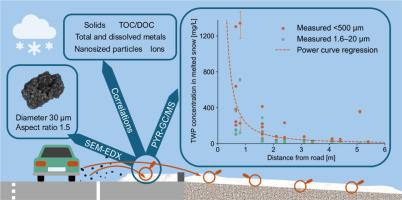瑞典公路雪中轮胎磨损颗粒的特征和空间分布:进入路边沟渠的负荷和融雪排放的风险
Q2 Environmental Science
引用次数: 0
摘要
轮胎磨损颗粒(TWP)是微塑料污染的重要来源,可以在道路附近的积雪中积累。研究了某高速公路近路环境中500µm和1.6 ~ 20µm两个粒径段TWP的特征、丰度和空间分布。通过热解-气相色谱/质谱(PYR-GC/MS)进行定量分析,同时通过扫描电镜和能量色散x射线(SEM-EDX)进行形态和元素分析。通过与选定的雨水相关参数(电导率、纳米颗粒浓度、总碳和溶解碳、有机碳、离子、总金属和溶解金属)的比较,研究了TWP的输运行为。结果表明:积雪中TWP浓度在7.8 ~ 1300 mg/L之间,随距离公路的远近而降低;在1.6 ~ 20µm细粒中,TWP含量丰富,含量变化较大,从0.3% ~ 98%不等,平均为48%。TWP与固体和金属浓度密切相关,表明类似的运输过程。SEM-EDX+ML分析显示,沥青和轮胎磨损颗粒是雪中固体物质中含量第二和第三高的成分,矿物质含量最高。轮胎和沥青磨损颗粒比之前分析的同一条高速公路上的道路灰尘看起来不那么细长。这些发现促进了对近道路积雪环境中TWP输送和分布的理解。鉴于融雪期间可能出现急性释放,需要采取缓解措施限制TWP排放和扩散,包括更好的积雪管理和处置做法。本文章由计算机程序翻译,如有差异,请以英文原文为准。

Characterisation and spatial distribution of tyre wear particles in Swedish highway snow: Loads into roadside ditches and risk of emissions with snowmelt
Tyre wear particles (TWP) are a significant source of microplastic pollution that can accumulate in road-adjacent snow. This study investigates characteristics, abundance and spatial distribution of TWP for two size fractions: <500 µm and 1.6–20 µm in the near-road environment of a highway. Quantification was done using Pyrolysis–Gas chromatography/Mass spectrometry (PYR-GC/MS), alongside morphological and elemental analyses by Scanning Electron Microscopy coupled with Energy Dispersive X-ray (SEM-EDX). Transport behaviour of TWP was investigated through comparison with selected stormwater related parameters (conductivity, nano-sized particle concentration, total and dissolved carbon and organic carbon, ions, total and dissolved metals). Results show that TWP concentrations in snow ranged between 7.8 and 1300 mg/L and concentrations decreased with distance from the highway. An abundant and varying proportion of TWP was found in the fine fraction 1.6–20 µm, ranging from 0.3% to 98% with an average of 48%. TWP strongly correlated with concentrations of solids and metals, suggesting similar transport processes. SEM-EDX+ML analyses showed that bitumen and tyre wear particles were the second and third most abundant components in the solid material in the snow, with minerals being the most abundant. Tyre and bitumen wear particles appeared less elongated than in road dust previously analysed from the same highway. These findings advance the understanding of TWP transport and distribution in near-road snow environments. Given the potential for acute release during snowmelt, mitigation measures limiting TWP emissions and spread, including better snow management and disposal practices are needed.
求助全文
通过发布文献求助,成功后即可免费获取论文全文。
去求助
来源期刊

Environmental Challenges
Environmental Science-Environmental Engineering
CiteScore
8.00
自引率
0.00%
发文量
249
审稿时长
8 weeks
 求助内容:
求助内容: 应助结果提醒方式:
应助结果提醒方式:


